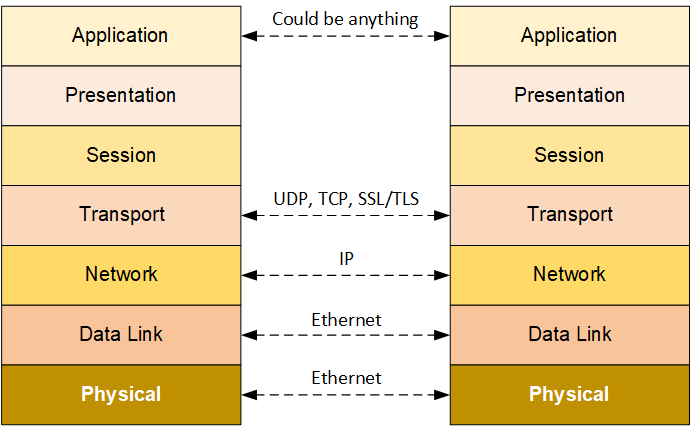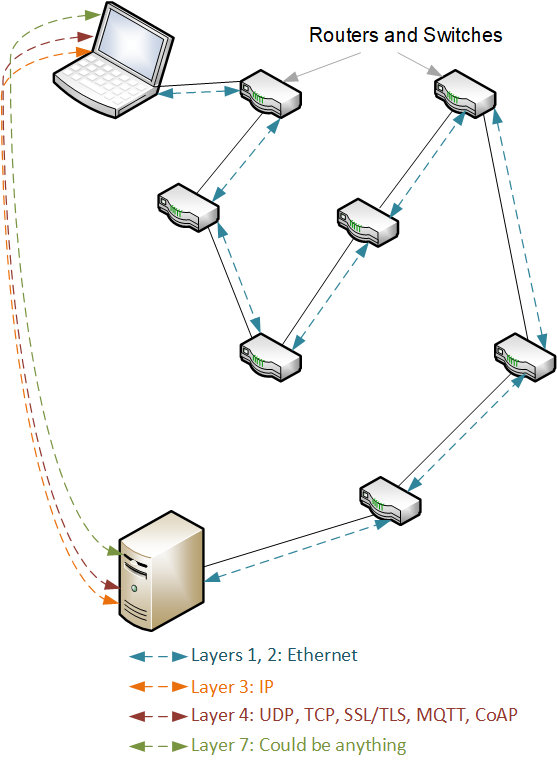
[From the last episode: There are different levels of “standardsA way of doing something specific that has been agreed by multiple parties in an official manner. Some "standards" aren't official standards; the best ones have been established in an open fashion, where anyone with an interest can contribute and where large companies can't push little companies around.,” only one of which is official. There are also alliancesA group of companies working together (in an anti-trust fashion) to promote a particular protocol or set of protocols. They’re like a standards body, but they don’t have the official imprimatur of a standards body.; both may come with ecosystemsA group of related businesses that agree to work together, typically through a somewhat formal organization that may have a brand name. If something like that existed, for, say, produce sold in a grocery store, then the ecosystem might include select farmers, distributors, transportation companies, and grocery stores..]
Now that we’ve talked about protocolsAn agreed way of doing something. Like a convention, except that protocols tend to be related to processes. and standards, we can look more specifically at how they relate to the stacks and the notion of interop, both of which we’ve already talked about.
Pretty much every layer of the OSI model is populated by standards. Are these standards the best way to do things? Maybe, maybe not. Sometimes the best technical standard wins. In other cases, a deep-pocketed company can engineer the standardization of a protocol that may not be the best. In either case, someone else may subsequently try to propose changes to improve things. The point being, standards aren’t necessarily static; new ones or improvements are often in the works.
So, if some aspiring engineer thinks that some standard isn’t the best way to do something, then why not simply invent a new one and do it better? Because of interopThis refers to how well different pieces of equipment can work together. Macs and PCs, for instance have some limited interop, but there are many Mac devices that can't work on a PC, and vice versa. This is an important notion for systems, like the IoT, that involve many different pieces of equipment working together.. And that’s why we’ve focused so much on communication; it’s where interop is hardest.
When some device does what it does all by itself, in isolation, it doesn’t matter if it’s using standards or not. But when it tries to interact with another device, well, that’s communication – by definition. And that’s where the interop problem lies. If you’ve got your own “best” way of communicating, but the other guy doesn’t understand your way, it’s of no use.
So interop is largely about communicating in mutually intelligible ways. And an ecosystem or walled garden consists of devices that speak the same “language” – where “language” really means “standard.”
Standards in the Stack
So let’s walk through the stackRelated to communications: A way of organizing parts of a complicated process (like communications) so that any task relies on tasks below it and feeds the tasks above it. Related to computing: A place in memory where you store “where was I?” information when you go from, say, one function into another. Before starting a new function, you store where you were in the old one so that, when the new function ends and you’re back in the old one, you can figure out where you were and continue on. to see what this m eans in practice.
eans in practice.
Layer 1
Layer 1 is physical. It’s wires and voltagesVoltage is what gets electrons to flow. It's analogous to water pressure, which gets water to flow. Voltage is measured in units of "volts.". There are some standards that cover only Layer 1, but not many. The most common low-level standard for wired communication is EthernetA very common Layer 1 and 2 standard for wired network connections., and it covers Layers 1 and 2. In other words, it has to worry about only one link in the networkA collection of items like computers, printers, phones, and other electronic items that are connected together by switches and routers. A network allows the connected devices to talk to each other electronically. The internet is an example of an extremely large network. Your home network, if you have one, is an example of a small local network. – the next hop. If that link uses Ethernet, then both ends of the link know what’s going on.
Layer 2
Layer 2, then, deals with how to get onto the network to get to the next hop and how to format the data so that the other end of the link will understand it. Again, Ethernet is most common here for wired communication.
Layer 3
Layer 3 deals not with just one link of the network, but with the whole network, end to end. So it doesn’t worry about the individual hops (since they’re already covered by Layers 1 and 2); it worries about where the end destination is. And the most common standard here is IPThis can mean two things (at least):
• The Internet Protocol. Governs the addresses of sources and destinations on a network (without worrying about what’s in between). Used on Layer 3 of the stack.
• "Intellectual property." This can have lots of meanings, but, in the computer-chip world, it refers to parts of a chip design that have been built and optimized by one company, which then sells them to other companies that don’t want to design those blocks themselves. They’re not selling actual chips; they’re selling the design of a block that will be used within a chip.
, or the Internet Protocol. As we’ve noted, it’s where the IP address comes from.
Layer 4
Layer 4 covers “transport” – that is, things like setting up communication links, message reliability, and securityRefers to whether or not IoT devices or data are protected from unauthorized viewers. (although Layers 2 and 3 can also have security of their own). There are two really common standards here: UDPUser Datagram Protocol. A “best effort” (i.e., no guarantees) way to get a message from one place to another. Used on Layer 4 of the stack. and TCPTransmission Control Protocol. A more reliable way to set up connections that might have two-way traffic or need better guarantees that messages get delivered. Used on Layer 4 of the stack..
UDP is a “toss it over the wall” standard, and basic websites use it. You have no guarantee you’ll get through, but most often you’re successful. Remember when we talked about requesting a web page? UDP is used for simple web page requests, and that request might not be received if the network is clogged with trafficRefers to any kind of electronic message -- email, web request, streaming video, or anything else -- that travels over a network.. If that request does get lost, you may have to try again (meaning, click on the link again).
TCP is more for sustained connectionsThis refers to some kind of electrical connection. It might be through a network cable, a cable connection, a wireless connection, or a phone - just to name some options. The connection might be to the internet or to some other local device. that need to be sure that messages get through. And SSLSecure Sockets Layer. A common internet security protocol. TLS is a more recent version of this, but SSL is still used. Works with TCP on Layer 4 of the stack. and the more modern TLSTransport Layer Security. A very common internet security protocol. You can think of it as an updated version of SSL, although both are still used. Used with TCP on Layer 4 of the stack. are security standards that work with TCP to provide encryptionEncryption refers to encoding and decoding (or encrypting and decrypting) data so that it can't be read unless you have the right key. It's critical for good security.. You may also have heard the phrase, “TCPIP” – which is more accurately written “TCP/IPPronounced “TCPIP” or “TCP over IP.” A common configuration where TCP is used on Layer 4 and IP is used on Layer 3.” and is sometimes pronounced “TCP over IP.” That’s a really common combination, and it means that a device uses TCP for Layer 4 and IP for Layer 3. On the stack, TCP lies atop IP, hence the “over.”
For the IoTThe Internet of Things. A broad term covering many different applications where "things" are interconnected through the internet., there are other transport standards that require less computing than TCP (since many IoT gadgets don’t have a lot of computing horsepower); standards like MQTTA lightweight transport protocol for Layer 4; may be more appropriate for IoT equipment. and CoAPA communications protocol that uses the RESTful approach for small systems such as those used for the IoT.. Think of them as “transport lite.”
Layers 5 and 6
We don’t really need to worry about Layer 5.
And we don’t really need to worry about Layer 6.
Layer 7
Layer 7 is for applications, and this is the layer where people may try to roll their own. It completely depends on what’s being done. Medical equipment might work one way; video equipment another; and so forth. There might be a medical standard for this layer, or there might not be. Same with any other application. Again, it’s all about the language spoken.
This is often where walled gardensAn approach to the IoT that restricts which devices and brands you can have work together. It could protect you, help assure interoperability, keep out certain competitors, or any and all of the above. are built. You can use all the common standards in the lower level of the stack and still limit interop by using a private language at the top level. If a manufacturer chooses to do this, they’re trying to control whom they can talk to – and, thereby, which devices can work together.
Practical IoT Interop
So, when you purchase a device, you don’t need to know in detail how the device communicates on every level. But you do want to make sure you know what other devices it can talk to. Often, you’ll start the other way around: perhaps with a major family like Google Home, Apple Homekit, or Amazon Echo. Then you see what other devices work with them and make your choice accordingly.
To be clear, you have choices beyond just those three, but those are dominant players, and we’ll have to see which ecosystems besides those three manage to survive what promises to be a punishing market battle.
After a break for a couple of application-oriented stories, we’ll come back to look at those Big 3 ecosystems to see how they differ.


Leave a Reply